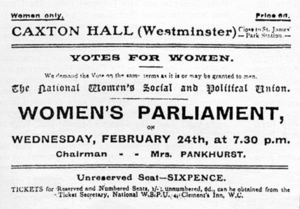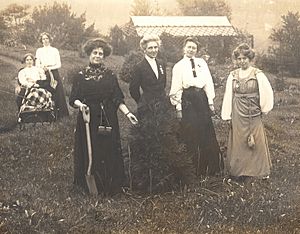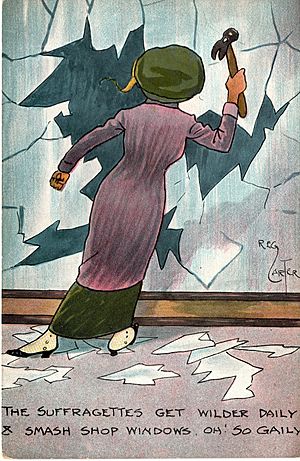Florence Haig facts for kids
Quick facts for kids
Florence Haig
|
|
|---|---|

Portrait of Haig, cropped from a group photograph
|
|
| Born |
Florence Eliza Haig
1856 Berwickshire, Scotland
|
| Died | 1952 (aged 95–96) Wandsworth, England
|
| Nationality | Scottish |
| Known for | Suffragette, artist |
| Relatives | Field Marshall Douglas Haig (cousin) Janet Boyd, suffragette (cousin) |
| Awards | Hunger Strike Medal 'for Valour' |
Florence Eliza Haig (1856–1952) was a Scottish artist and a brave suffragette. She fought for women's right to vote. She was even given a special medal for going to prison and going on hunger strike to support her cause.
Contents
Who Was Florence Haig?
Florence Haig was born in Scotland in 1856. Her father was a lawyer in Berwickshire. She had two sisters, Cecilia and Evelyn. Her cousin, Douglas Haig, became a famous military leader in 1915. Florence was also an artist. She created a pastel drawing of a scientist named John Tyndall. A copy of this drawing is kept in the National Portrait Gallery, London.
Joining the Fight for Votes
Florence first supported the women's suffrage movement in 1901. She gave money to a group called the National Union of Women's Suffrage Societies. In 1907, she became interested in a different group. This was the Women's Social and Political Union (WSPU). This group was more active and daring in their protests. It was led by Emmeline Pankhurst. Florence saw them in action at a meeting called the "Women's Parliament." This meeting happened on February 24, 1907, at Caxton Hall.
Florence and her sister, Evelyn, started a WSPU group in Edinburgh. But Florence soon moved to London. She met a young woman named Grace Roe while suffragettes were writing messages on the pavement. Florence invited Grace to a protest in Hyde Park. Grace was inspired by Christabel Pankhurst, Emmeline's daughter. Florence became a founder of the East London Federation of Suffragettes. She used her art studio in Limehouse to help women from all walks of life work together.
Daring Protests and Arrests
In 1908, Florence was part of a group with Emmeline Pankhurst. They tried to meet the Prime Minister but were not successful. A year after the "Women's Parliament," Florence took part in a bold plan. It was called the "pantechnicon raid." A pantechnicon is a large furniture van. They used it like a "Trojan Horse" to get twenty suffragettes close to the House of Commons. Florence, along with Maria Brackenbury and Georgina Brackenbury, tried to rush into the building. They were arrested and sentenced to six weeks in prison. When she was released, Florence said that every woman who acts helps others. She felt that friends who were only slightly interested became active supporters.
Florence's time in prison was celebrated by the suffrage leaders. Later, her hunger strike was also honored.
The Suffragette's Rest
Florence was allowed to plant a special tree at a place called "the Suffragette's Rest." This was the nickname for Eagle House in Somerset. It was the home of Mary Blathwayt. Mary's parents were very supportive of the WSPU. They welcomed women who needed to recover after being in prison. They set aside land to plant a tree for each WSPU member who went to prison for the cause. Mary's father would take photos of the tree plantings. These trees and photos recorded the women's brave actions. This special area was known as 'Annie's Arboretum,' named after suffragette Annie Kenney.
In 1912, the WSPU organized a big protest. Many women broke windows in London's Oxford Street. Florence took part, even though her sister Cecilia had recently passed away. She broke windows at a store called D.H.Evans. She was arrested with her cousin Janet Boyd. Florence received a four-month prison sentence for her actions.
Hunger Strike and Medal
As soon as she was in prison, Florence went on a hunger strike. This meant she refused to eat to protest her imprisonment. After four days, she was released.
The WSPU gave Florence a special award called the Hunger Strike Medal. It had 'For Valour' engraved on it, meaning 'For Bravery.' The medal's inscription said it was given "IN RECOGNITION OF A GALLANT ACTION, WHEREBY THROUGH ENDURANCE TO THE LAST EXTREMITY OF HUNGER AND HARDSHIP A GREAT PRINCIPLE OF POLITICAL JUSTICE WAS VINDICATED." The medal's ribbon had the WSPU colors: green, white, and purple. Florence's medal is now in the Museum of London.
Later Life
When World War I began, Florence left the East London Federation. She joined Emmeline Pankhurst and others in stopping their protests. They decided to support the war effort instead. In June 1928, Florence was chosen to be one of the women who carried Emmeline Pankhurst's coffin at her funeral.
Florence continued to show her artwork regularly. In 1934, she joined the Society of Women Artists.
Florence Haig passed away in Wandsworth, London, in 1952.




